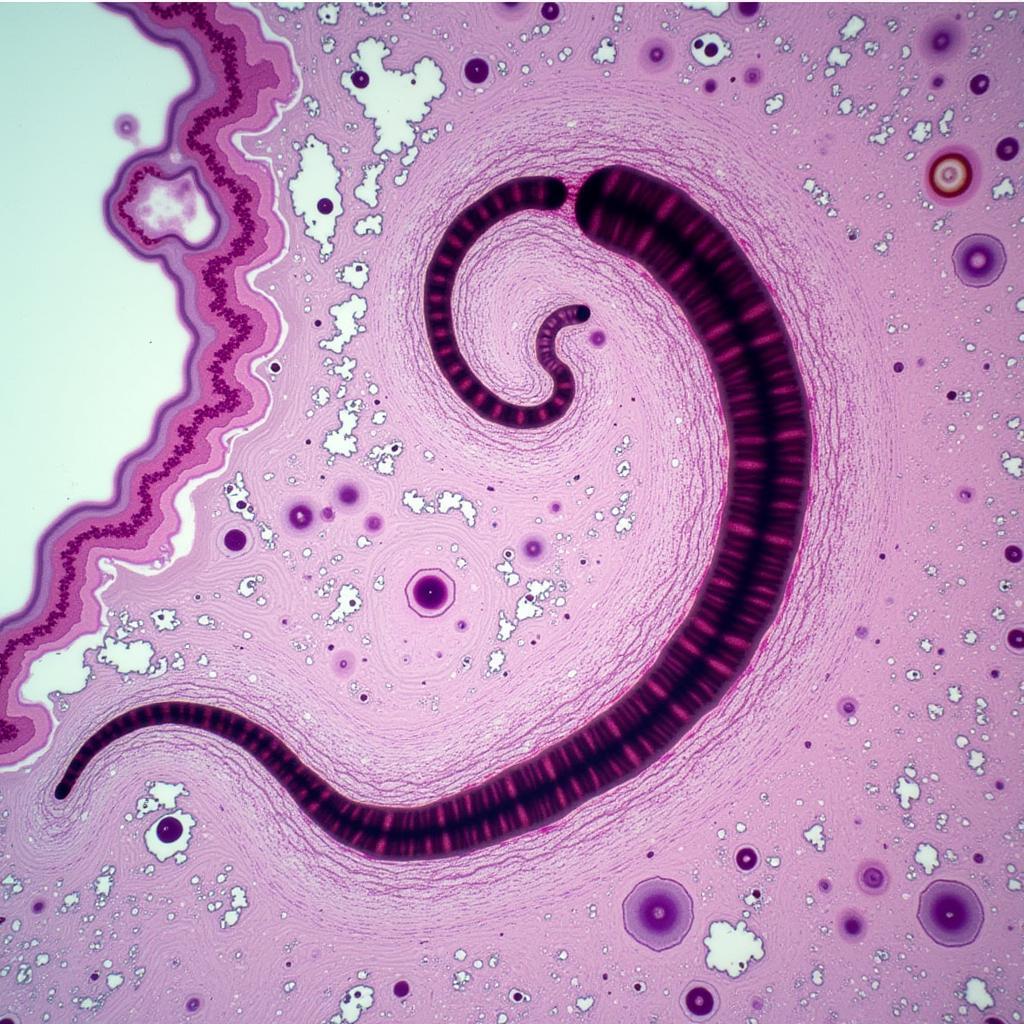What Causes African Sleeping Sickness?
African sleeping sickness, also known as Human African Trypanosomiasis (HAT), is a debilitating parasitic disease. It’s a serious public health concern in sub-Saharan Africa, affecting thousands annually. What causes this devastating illness? Let’s delve into the intricacies of this disease and uncover the root cause of African sleeping sickness. african sleeping sickness is caused by
Understanding the Parasite Behind African Sleeping Sickness
African sleeping sickness is caused by a microscopic parasite called Trypanosoma. There are two main species that cause the disease in humans: Trypanosoma brucei gambiense (T.b. gambiense) and Trypanosoma brucei rhodesiense (T.b. rhodesiense). Understanding the differences between these two species is crucial for effective diagnosis and treatment. T.b. gambiense is responsible for the majority of cases (over 98%) and causes a chronic form of the disease, often taking years to develop. T.b. rhodesiense, on the other hand, causes a more acute form of the disease that progresses rapidly.
 African Sleeping Sickness Parasite – Trypanosoma
African Sleeping Sickness Parasite – Trypanosoma
How is African Sleeping Sickness Transmitted?
The primary mode of transmission for African sleeping sickness is through the bite of an infected tsetse fly. These flies, belonging to the genus Glossina, are found exclusively in sub-Saharan Africa. When an infected tsetse fly bites a human, the parasites are injected into the bloodstream, initiating the infection. Understanding the role of the tsetse fly in the transmission cycle is vital for implementing effective control measures. african sleeping sickness is transmitted by
Other, Less Common Modes of Transmission
While the tsetse fly bite is the most common way African sleeping sickness is spread, there are other, less frequent methods of transmission. These include:
- Mother-to-child transmission: The parasite can cross the placenta and infect the unborn child.
- Mechanical transmission: Although rare, transmission can occur through other biting insects, such as stable flies, acting as mechanical vectors.
- Accidental transmission: Laboratory accidents or contamination of medical equipment can also lead to infection, although this is extremely rare.
Symptoms and Stages of African Sleeping Sickness
The progression of African sleeping sickness can be broadly divided into two stages. The first stage, known as the haemolymphatic stage, involves fever, headaches, joint pains, and swollen lymph nodes. The second stage, the neurological stage, occurs when the parasites cross the blood-brain barrier and enter the central nervous system. This stage is characterized by more severe neurological symptoms, including confusion, sleep disturbances, seizures, and eventually coma. african sleeping sickness is due to
What are the long-term effects of untreated African sleeping sickness?
If left untreated, African sleeping sickness can be fatal. The neurological damage caused by the parasite can lead to irreversible brain damage and eventually death. Early diagnosis and treatment are essential to prevent the progression to the neurological stage and minimize long-term complications.
Dr. Abimbola Akinola, a leading infectious disease specialist in Nigeria, emphasizes the importance of early intervention: “Early diagnosis is key to effectively managing African sleeping sickness. The sooner treatment begins, the better the chances of a full recovery.”
Diagnosis and Treatment of African Sleeping Sickness
Diagnosing African sleeping sickness involves microscopic examination of blood, lymph node fluid, or cerebrospinal fluid to detect the presence of the parasite. Several treatments are available for both stages of the disease, including pentamidine, suramin, eflornithine, nifurtimox, and melarsoprol. The choice of treatment depends on the stage of the disease and the species of the parasite involved.
Prevention and Control of African Sleeping Sickness
Preventing African sleeping sickness involves strategies aimed at reducing the risk of tsetse fly bites and controlling tsetse fly populations. These strategies include:
- Vector control: Methods like insecticide-treated traps and aerial spraying can help reduce tsetse fly populations.
- Protective clothing: Wearing long-sleeved shirts and trousers can minimize exposure to tsetse flies.
- Community education: Educating communities about the disease and its transmission can help raise awareness and promote preventative measures.
Professor Khadija Mohamud, a renowned entomologist from Kenya, stresses the importance of integrated vector management: “Sustainable control of tsetse fly populations requires a multi-faceted approach that combines various vector control methods with community engagement.” african illness a case of parasites african trypanosomiasis pdf
Conclusion
African sleeping sickness, caused by the Trypanosoma parasite and transmitted by the tsetse fly, remains a serious health threat in sub-Saharan Africa. Understanding what causes this disease, its transmission, symptoms, and available treatment options is crucial for effective management and control. Early diagnosis and prompt treatment are essential for a positive outcome. By implementing comprehensive prevention strategies and raising public awareness, we can work towards eliminating this debilitating disease.
FAQ
- What are the early signs of African sleeping sickness?
- How is African sleeping sickness diagnosed?
- Are there effective treatments for African sleeping sickness?
- How can I protect myself from tsetse fly bites?
- What are the long-term consequences of untreated African sleeping sickness?
- Where can I find more information about African sleeping sickness?
- What is the role of public health programs in controlling African sleeping sickness?
Scenarios
- Scenario 1: A traveler returning from a safari in East Africa develops a fever, headache, and swollen lymph nodes.
- Scenario 2: A pregnant woman in a rural village in West Africa tests positive for African sleeping sickness.
- Scenario 3: A healthcare worker in a remote clinic in Central Africa accidentally pricks themselves with a contaminated needle while treating a patient with African sleeping sickness.
Further Reading and Resources
- Learn more about the life cycle of the tsetse fly.
- Explore the latest research on new treatments for African sleeping sickness.
- Find out about the impact of climate change on the distribution of tsetse flies.
For any assistance or further inquiries, please don’t hesitate to contact us:
Phone: +255768904061
Email: kaka.mag@gmail.com
Address: Mbarali DC Mawindi, Kangaga, Tanzania.
Our customer care team is available 24/7.

